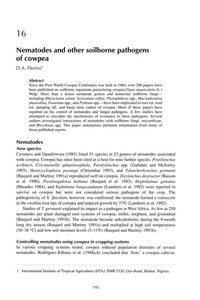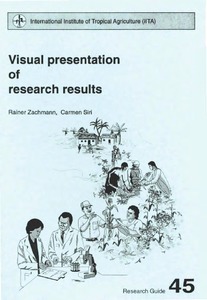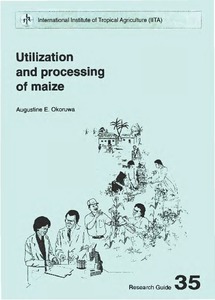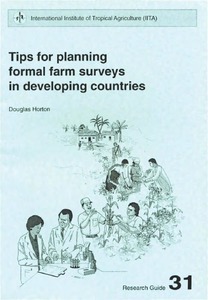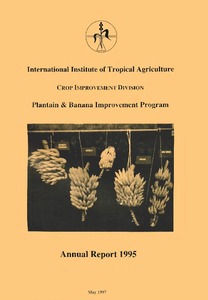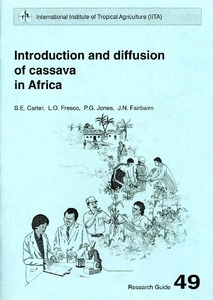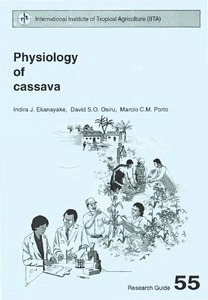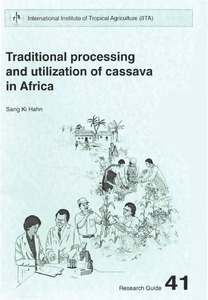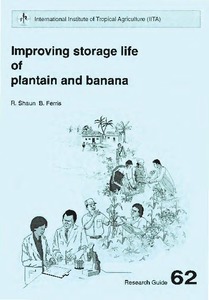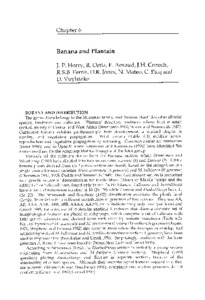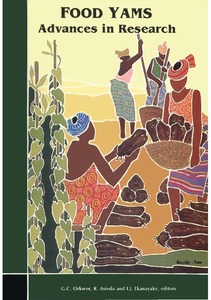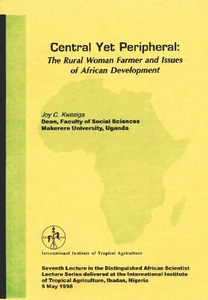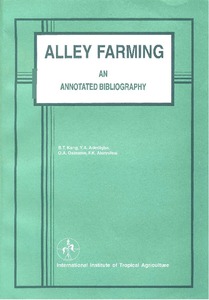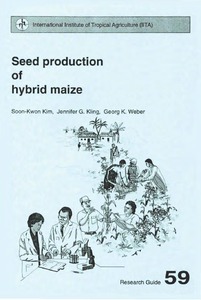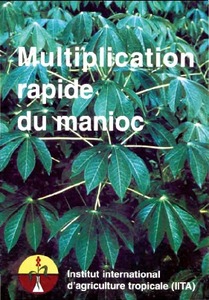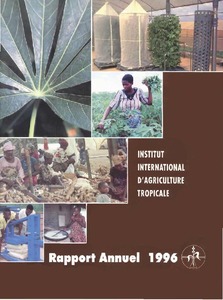Welcome to the International Institute of Tropical Agriculture Research Repository
Books and Book Chapters: Recent submissions
Now showing items 721-740 of 983
-
Tractor design and operation for research stations: IITA research guide, No. 4
(1998)The agricultural tractor has passed through a long evolution from the early steam-powered machines to the modern petrol and diesel engine tractors of today. The hydraulic system, power take off, and auxiliary modules have greatly extended the capabilities of tractors. Today, the reliability of tractors depends almost entirely upon proper maintenance. However, tractors are inherently dangerous and must be operated with care. -
Postharvest physiology of plantain and banana: IITA research guide, No 64
(1998)Postharvest research is concerned with maintaining crop quality until the crop reaches the consumer. Postharvest physiology includes study of the physiological development of fruits, and their metabolic processes, especially transpiration and respiration. Postharvest improvements aim to slow down these processes, to extend storage life, and improve fruit quality. -
Nematodes and other soilborne pathogens of cowpea
(1997)Since the First World Cowpea Conference was held in 1984, over 200 papers have been published on soilborne organisms parasitizing eowpea.V/o/za unguiculata (L.) Walp. More than a dozen nematode genera and numerous soilborne fungi including Rhizoctonia solanL cleroriitm rotfsii, Phytophthora spp., Macrophonrina phaseoliiw, Fusarhtm spp., and Pyihium spp.—have been implicated in root rot, seed rot, damping off. and basal stem canker of cowpea. Most of these papers have reported on the control of ... -
Visual presentation of research results: IITA research guide, No. 45
(1998)Well prepared visual aids improve communication of research results and enhance the impact of your presentation. Your research will be more appreciated. However, poor visual aids ruin even the best message. You can spoil a presentation by presenting badly prepared visual aids, or by presenting visual aids badly. This Research Guide summarizes recommendations on how to plan, prepare, and deliver visual presentation of research results. It concentrates on visual aids containing text, tables, and ... -
Utilization and processing of maize: IITA research guide, No. 35
(1997)Maize is of high important among the world's cereal crops. Maize can be used for human consumption, animal feed, and industrial purpose. Many traditional and industrial maize processing methods exist. Industrial processing includes wet and dry milling to produce a wide variety of products. Many maize dishes are prepared in Africa and elsewhere as human food. -
Tips for planning formal farm surveys in developing countries: IITA research guide, No. 31
(1997)Formal surveys are powerful tools in gathering information from farmers I order to arrive at wise decisions in the implementation of agriculture development projects. However, formal surveys must be used with common sense and a dedication to clear focus by gathering useful data. The temptation to construct long, awkward questionnaires involving interesting but essentially irrelevant questions must be avoided. Above all, however, we should demand that the survey yield information that will help to ... -
Introduction and diffusion of cassava in Africa: IITA research guide, No. 49
(1997)From the 15th to the 17th centuries, Portuguese explorers established forts, trading stations and settlements on the Mrican coasts and nearby islands. Prior to 1600 they began to introduce cassava at these points. From there it was diffused by Mricans, to reach many parts of the interior over the space of two to three hundred years. Cassava is now found in almost all parts of tropical Africa where conditions are suitable for its cultivation. In the course of its spread across the continent, cassava ... -
Morphology and growth of plantain and banana: IITA research guide, No. 66
(1997)Plantain and banana (Musa s pp.J are giant perennial herbs which originated in Southeast Asia. Musa is an important food crop in the humid forest and mid-altitude ecologies of sub-Saharan Africa. Several criteria are used to distinguish the different types of cultivated plantain and banana, evolved from M . acu-minata and M. balbisiana. The corm is the real stem of the Musa plant and produces 10-15 buds, which may develop into branches called suckers. Suckers are used as planting material. Foliage ... -
Traditional processing and utilization of cassava in Africa: IITA research guide, No. 41
(1997)Cassava is playing a major role in African food systems. Processing of cassava has several objectives and advantages. Traditionally, cassava is processed into many products. However, several constraints affect cassava processing. Cyanide content in the roots is a major limitation of cassava utilization, but can be reduced by appropriate processing. Traditional processing does not require sophisticated equipment, but storage requirement of the processed products are critical. At many locations, ... -
Improving storage life of plantain and banana: IITA research guide, No. 62
(1997)Plantain and banana are important food crops in the humid zone of sub-saharan Africa. A major problem of plantain and banana is that the fruits are highly perishable. Researchers, therefore, look for ways to extend storage life. Several methods can be used to extend storage life. The most important physiological functions affecting product quality during storage are respiration and transpiration,. To extend storage life, these functions should be reduced. This can be done by controlling temperature, ... -
Banana and plantain
(1997) -
Screening for abiotic stress resistance in root and tuber crops: IITA research guide, No. 68
(1998)The main abiotic stress factors affecting root and tuber crops in sub-Saharan Africa are drought, waterlogging, temperature extremes, solar radiation extremes, and nutrient imbalances. To reduce the effects of abiotic stress, researchers breed crops that have high levels of resistance to the relevant stress factors. Researchers identify traits that confer resistance to stress factors. Genotypes with desirable traits are selected by screening, and used to breed populations with improved resistance. -
Food yams: advances in research
(1998) -
Seed production of hybrid maize: IITA research guide, No. 59
(1999)Hybrid maize seed was the first commercially available F1 seed. Inbred lines serve as parents for commercial production of single-cross hybrid seed. Cooperation between seed companies, research institutes, and government institutions is essential to the successful development of productive hybrids. Commercial hybrid seed production requires proper ecological location, agronomic practices, pest and disease control. Additional elements necessary for a successful hybrid seed industry include seed ... -
Multiplication rapide du manioc
(1997) -
Rapport Annuel IITA 1996
(1997)



